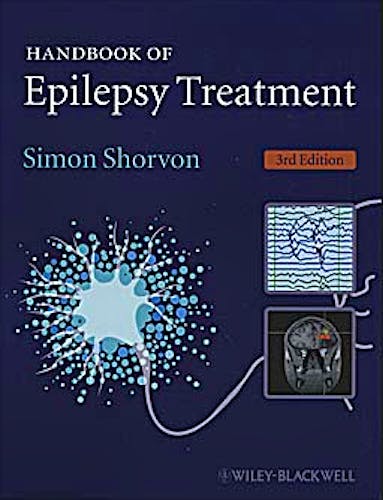

No hay productos en el carrito



Handbook of Epilepsy Treatment
Shorvon, S.
3ª Edición Noviembre 2010
Inglés
Tapa blanda
436 pags
1500 gr
19 x 25 x 2 cm
ISBN 9781405198189
Editorial WILEY
LIBRO IMPRESO
-5%
82,27 €78,16 €IVA incluido
79,11 €75,15 €IVA no incluido
Recíbelo en un plazo de
2 - 3 semanas
LIBRO ELECTRÓNICO
-5%
71,75 €68,16 €IVA incluido
68,99 €65,54 €IVA no incluido
Acceso On Line
Inmediato
Description
Epilepsy is a complex neurological condition. There are many modern treatment options, and treatment should nowadays be tailored to an individual patient. But identification of the best therapy can be a labyrinthine process.
The Handbook of Epilepsy Treatment provides a practical pathfinder for treating epilepsy based on published evidence and the author’s 30 years of specialist clinical experience. Direct in style but comprehensive in content, with ample tables and summaries, the Handbook of Epilepsy Treatment covers:
- Treatment of the different forms and causes of epilepsy
- Treatment in the different commonly encountered clinical situations
- Treatment in children, in adults, in the elderly, in women, in epilepsy syndromes and in those with special needs and requirements
- Epilepsy drugs – their pharmacology, kinetics, side effects, effectiveness and practical usage in the clinic
- Epilepsy surgery – the various types, the indications, assessment and outcome
A succinct pharmacopeia summarizes the entire range of anti-epileptic medications with emphasis on effective prescribing in the clinical setting.
The Handbook of Epilepsy Treatment will help you and your patient find the best path to control epilepsy for each individual’s situation.
Table of Contents
Preface to the Third Edition.
Acknowledgements.
1 Definitions and Epidemiology.
- Definitions.
- Frequency and population features of epilepsy.
2 Seizure Type and Anatomical Location of Seizures.
- Seizure type.
- Classifi cation of partial seizures by anatomical site of seizure onset.
3 Epilepsy Syndromes.
- ILAE Classifi cation of the Epilepsies and Epilepsy Syndromes.
- The epilepsy syndromes.
4 The Causes of Epilepsy.
- Idiopathic epilepsy.
- Symptomatic epilepsy of genetic or congenital origin.
- Symptomatic epilepsy due to acquired causes.
- Provoked seizures.
5 Principles of Treatment.
- Why treat epilepsy? The aims of treatment.
- The risks of epilepsy and its treatment.
- Choice of antiepileptic drug therapy based on seizure type.
- Treatment of specifi c epilepsy syndromes.
- Principles of treatment of newly diagnosed patients.
- Principles of treatment of patients with established active epilepsy.
- Treatment of patients with epilepsy in remission.
- Psychiatric disorders in epilepsy.
- Life-threatening idiosyncratic reactions.
- Complementary and alternative therapy in epilepsy.
- Genetic counselling in epilepsy.
6 Treatment of Epilepsy in Specifi c Groups.
- Treatment of epilepsy in children.
- Treatment of epilepsy in patients with additional handicaps.
- Epilepsy in elderly people.
- Treatment of epilepsy in women.
7 Pharmacokinetic Principles of Antiepileptic Drug Treatment.
- Drug absorption.
- Drug distribution.
- Drug elimination (metabolism and excretion).
- Blood level measurements.
8 The Antiepileptic Drugs.
- Carbamazepine.
- Clobazam.
- Clonazepam.
- Eslicarbazepine acetate.
- Ethosuximide.
- Gabapentin.
- Lacosamide.
- Lamotrigine.
- Levetiracetam.
- Oxcarbazepine.
- Phenobarbital.
- Phenytoin.
- Pregabalin.
- Primidone.
- Rufi namide.
- Tiagabine.
- Topiramate.
- Valproate.
- Vigabatrin.
- Zonisamide.
- Other drugs used in the treatment of epilepsy.
- Acetazolamide.
- Benzodiazepines.
- Corticosteroids and ACTH.
- Felbamate.
- Piracetam.
- Stiripentol.
9 The Emergency Treatment of Epilepsy.
- How to deal with a seizure.
- Status epilepticus.
- Antiepileptic drugs used in status epilepticus.
10 The Surgical Therapy of Epilepsy.
- Presurgical assessment – general points.
- Surgery in epilepsy arising in the mesial temporal lobe.
- Surgery in epilepsy arising in extratemporal regions and the temporal neocortex.
- Cortical dysplasia (malformations of cortical development).
- Surgery where no lesion is apparent on neuroimaging ('MRI-negative cases')
- Hemispherectomy, hemispherotomy and other large resections.
- Corpus callosectomy (corpus callosum section, corpus callosotomy).
- Multiple subpial transection.
- Vagal nerve stimulation.
- Other functional surgical procedures.
- The organization of epilepsy surgery care: the epilepsy surgery centre.
- Pharmacopoeia.
- Antiepileptic drugs – indications in epilepsy.
- Antiepileptic drugs – dose, average adult values.
- Antiepileptic drugs – dose, interactions.
- Antiepileptic drugs – dose, in children.
- Antiepileptic drugs – summary of side effects.
- Antiepileptic drugs – summary of metabolism.
- Antiepileptic drugs – summary of pharmacokinetic values (typical adult values).
- Antiepileptic drugs – modes of action.
- Further Reading.
Index.
Author Information
Simon Shorvon, MD, Professor of Neurology, Institute of Neurology, University College London, Queen Square, London, UK
Reviews of previous editions
"This delightful new handbook...is excellent, well written, and practical...by
one of the leading figures in clinical epilepsy today...This stylishly written
book serves its purpose admirably. It is a superb handbook that will be of immediate
value as a reference or review on the treatment of epilepsy for the general
neurologist as well as for the experienced epileptologist" (Annals of Neurology)
"...an excellent didactic tool and a very important hands-on text for all people involved in the care of epileptic patient. The factual information is easy to access, given the numerous tables that summarize the various sections, the comprehensive tabulation of data available, and the pharmacopeia appendix" (Child’s Nervous System)
© 2025 Axón Librería S.L.
2.149.0